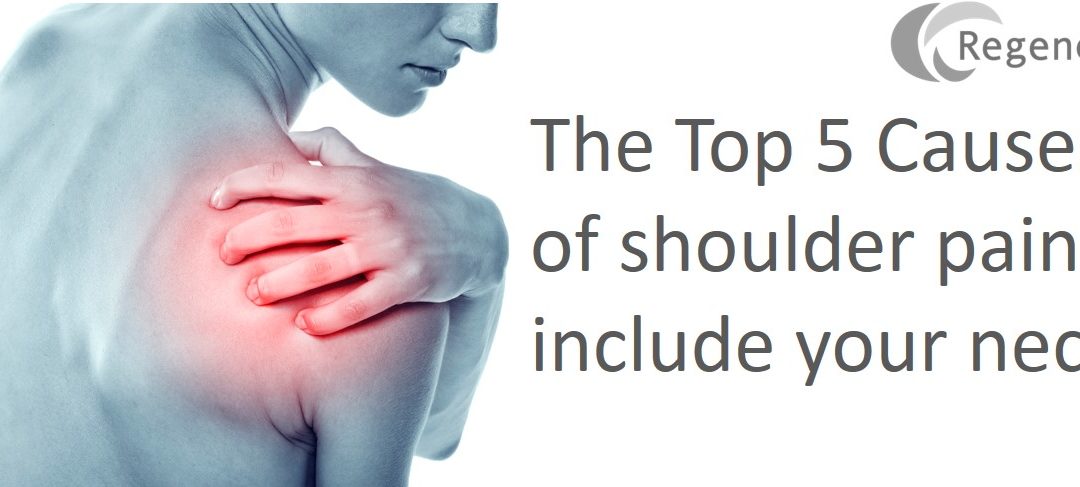Over any 10 year period, about 15% of us will see a doctor for shoulder pain and that number climbs as we get older. While you might think that only one or two things can cause pain in the shoulder, there are actually quite a few. These most common shoulder problems include the various structures inside the shoulder and very commonly, the neck.
Here are the top 5 most common shoulder problems by the frequency we diagnose them:
1. Tendinitis due to bad bio-mechanics: Tendinitis in the shoulder means that the tendons of the rotator cuff or biceps are swollen and “pissed off”. Patients can have just achy pain, more at night or with certain activities or if the issue is severe, may be unable to put on a shirt. This issue is usually caused by sloppy or abnormal motion of the shoulder joint. It’s usually fixed with simple physical therapy exercises, but when it doesn’t get better that way, do not allow your physician to inject an anesthetic and high dose steroids into the area! There’s mounting evidence that this hurts the tissues in the long-run, leading to more problems down the road. A better option is to use an ultrasound guided platelet rich plasma shot (your own concentrated blood platelets).
2. Rotator cuff problems-The rotator cuff is a group of muscles that both move the shoulder joint and more importantly stabilize the structure. The tendon of the muscle can become worn as we age and this can lead to tears as this area loses blood supply. Many times these tears happen with some minor trauma and sometimes with very little to no trauma. Patients can have a hard time exercising or dressing and shoulder may feel like it gives way at times. While physical therapy is initially recommended, the patients who fail that step and who have a bigger tear are usually sent to surgery to sew back together the torn pieces. Regrettably, recent research has shown that rotator cuff surgery isn’t all that successful. In one trial it was no more effective than physical therapy. One of the problems is that the tendon can easily re-tear. Recent research has shown that for bigger tears that require surgery, an injection of stem cells can halve the re-tear rate. In addition, in our extensive experience, many patients can be treated without the surgery and just an injection of their own stem cells, leading to a much faster recovery.
3. Biceps and SLAP Lesions-The biceps muscle is the big one you see in the front of the arm. The main shoulder joint is a ball and socket affair with the biceps tendon anchoring up at the top of the socket. Either through wear and tear or trauma, the biceps tendon can become damaged or begin to pull off it’s anchor point, known as the superior labral attachment (SLA). This last type of tear, high up and inside the shoulder, is called a SLAP tear. The patient usually has pain with using the biceps or with movement in the front. A SLAP lesion is usually repaired surgically, although this is a massive surgery where the tendon may need to be unattached and then reattached, greatly increasing recovery and down-time. Another method to treat many shoulder SLAP tears is a precise x-ray and ultrasound guided injection of the patient’s own stem cells, reducing recovery time.
4. Neck-Believe or not, you can have a little stiffness in the neck and serious shoulder pain and have nothing wrong in the shoulder. In fact, this is the most common presentation of a pinched nerve in the lower neck. The patient will sometimes get numbness in the same hand, but not always. In fact, sometimes the numbness only comes at night. The pain is usually in the back or the top of the shoulder can can be quite severe, as nerves getting irritated or compressed is never a fun affair. This is a real problem for many patients, as often it fools their doctor’s as well. Usually an MRI is taken of the shoulder and some small smoldering issue is seen and declared the cause of the patient’s problem. However, treatment for that problem brings little or incomplete relief. Once an accurate diagnosis is made, we’ve had great success with precisely injecting the growth factors from the patient’s blood platelets around the irritated nerves in the neck.
5. Labrum-The labrum in the shoulder is the lip around the socket of the ball and socket joint. This structure acts as a guide to help keep the ball of the shoulder joint in good position when the rotator cuff can’t do the job. The labrum can become degenerative from too much wear and tear and can also be injured with trauma. Patients tend to have deep seated shoulder pain that’s worse with certain movement, depending on where the labrum was injured (since it travels 360 around the socket in the front and back). Surgery is again a big deal with big recovery and risks. Physical therapy to strengthen the rotator cuff muscles and fix long-standing bio mechanical issues may help. Finally, we’ve had good success with precise injections of the patient’s own blood platelets or stem cells to help heal the shoulder labrum tear.
The upshot? There are allot of things that can cause your shoulder to hurt. The first part to getting better is getting diagnosed correctly. The second is trying to avoid invasive surgery!
See original post here: http://www.regenexx.com/2014/10/most-common-shoulder-problems/

